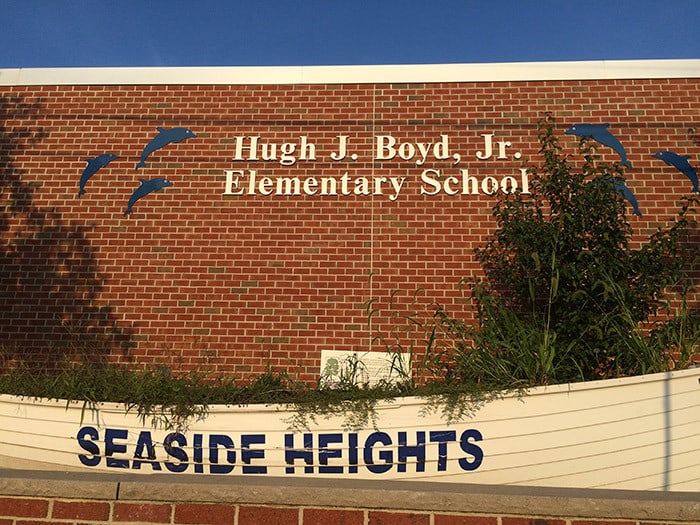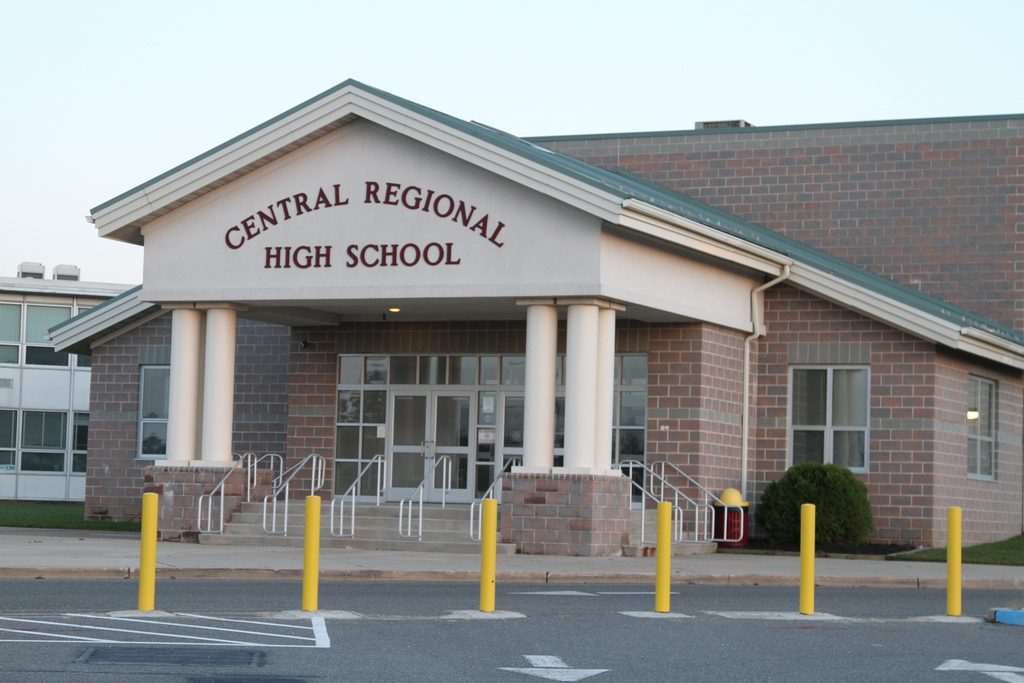The first portion of a two-part study looking into the feasibility of eliminating Seaside Heights as an operating school district was presented to officials in the borough, as well as Toms River, this week.
The study was commissioned by the borough after the state provided a grant to fund it amidst state aid requests from the municipal government to fill gaps in the town’s ratables base created in Superstorm Sandy’s aftermath. As part of the funding for essential services, Trenton officials began an effort to study Seaside Heights’ financial well-being, part of which included a two-part deep dive into the ramifications of continuing to operate a school district.
Seaside Heights offers pre-school to sixth grade classes at the Hugh J. Boyd Elementary School on Bay Boulevard. After being promoted from sixth grade, students move on to the Central Regional school district for middle school and high school classes. The two options being studied would end the borough’s relationship with Central Regional and either establish a sending-receiving relationship with the Toms River Regional school district (TRRS) or a full integration into the Toms River system.
Vito A. Gagliardi, a Morristown-based attorney who specializes in education law, led the study. The portion that was completed and presented to officials this week was authored by Steven Cea, an accountant who specializes in school finance. It also contained input from Mary Robinson-Cohen, a former teacher and Roosevelt Public School District superintendent who is also an attorney.
The Report
The first portion of the report focused on the PK-6 education provided by the Seaside Heights school district. (A copy of the 83-page report is embedded below.) Cohen took a major role in presenting the educational aspects of the report, which shed light on challenges faced by the district. The district, the report found, failed New Jersey’s Quality Single Accountability Continuum, or QSAC, a monitoring program that evaluates school districts and recommends areas in need of improvement. Students’ below-average performance on standardized tests was also examined as part of the probe.
The Seaside Heights district has long been unique in Ocean County, whose student population is overwhelmingly white and sociologically middle class. Seaside Heights, in contrast, has a large immigrant population whose children increasingly do not speak English natively, with another significant portion of its non-immigrant students originating from transient families residing in short-term seasonal rentals on the barrier island. The town, as widely reported, is changing rapidly, with motels and aging rental properties being replaced en masse by high-end condominiums and single-family homes that are occupied by retirees and seasonal residents. That is leading to a decline in student population as fewer low-cost rental units are available after Labor Day each year, resulting in a smaller population of students who require services some argue can only be provided in a larger district with wider resources.
“It goes to the core of the community – how their children are educated and how their tax dollars are spent,” said Gagliardi, introducing the scope of the document, which examines both the financial and educational aspects of what appears to be a realistic question that will be posed to officials over the next two to three years. “The state has been moving communities, mostly with public policy pronouncements, but now with taxpayer dollars, to regional school districts.”
Cohen admitted it was “sobering” to consider closing a school that has been operating in a community for decades, but pointed to “areas of concern” which could be addressed by regionalization.
“In all of the state testing, unfortunately, the children were lagging behind,” said Cohen. “There were no categories where the children were advanced-proficient and in the other categories they were minimally proficient. … There children were, mainly, below proficient.”
The study examined test results of exams administered both before and after the coronavirus pandemic.
Mayor Anthony Vaz, himself a retired schools superintendent in multiple districts, said the potential benefits to students attending a larger district cannot be ignored.
“I envision a community that is going to have fewer children in the future, because we see that decline. If someone is paying $800,000 or $1 million for a condo, they’re not going to rent it for $1,000 per month in the winter,” he said. “You can’t operate a school with a minimal amount of children, and you really can’t give a minimal amount of children a good education because you can’t support the services they may need.”
Potential Options
There are two paths Seaside Heights could take if the operations of its school district were to cease, both of which would see students education in Toms River Regional. One would be a sending-receiving relationship, under which the borough would pay per-student tuition to educate them in TRRS – most likely East Dover Elementary School at those grade levels. The other would be a full integration into TRRS, an arrangement under which Seaside Heights taxpayers would be assessed school taxes based on statutory formulas. Gagliardi said Toms River officials strongly prefer the full integration.
Regardless of which option may be pursued – if any – tenured teachers would retain their jobs and could not have their salaries or benefits reduced. But they would be assigned to teach in the Toms River district, likely with new supervisors and as part of the wider TRRS system.

Former Gov. Chris Christie cuts the ribbon reopening the Hugh J. Boyd Elementary School following Superstorm Sandy, Sept. 5, 2013. (Photo: Governor’s Office/ Tim Larsen)
Cea, the accountant, said closing the Boyd school would save taxpayer dollars.
“Seaside Heights, on average, each year … saves about $2 million,” said Cea, whose calculations took five-year blocks and averaged them out to produce annual savings figures. “In some years depending on enrollments it could be more, or less, but there is an average savings of $10 million over a five-year period.”
TRRS would generate about $400,000 in tuition revenue under a sending-receiving relationship. It was not clear how much money would be sent to the district by Seaside Heights taxpayers under a full integration, and numerous laws have been passed over the last two years that have overhauled how such consolidations work in New Jersey.
“Given the size of Toms River, it is possible to include the Seaside Heights students without a very large increase in class size,” said Cea, predicting an increase of about two or three students per class.
Seaside Heights has about 23 students per grade level.
“Since students will be in multiple schools, there is very little chance for an increase in administration across the board,” Cea added.
Additionally, under a sending-receiving relationship, Seaside Heights would be eligible for significant transportation aid from the state, which could increase the level of savings.
Cea did warn that the borough could face a challenge in the case of the student population dropping and the costs for an education at TRRS increasing simultaneously. Since New Jersey property taxes fall under a 2 percent cap in both expenditures and levy, the combination of the two factors could lead to a cap overage, which theoretically would necessitate cuts elsewhere.
“You can, however, build a budget that incorporates some of those savings and then create a reserve so you are protected in the case your tuition payment to Toms River exceeds the tax cap,” Cea said.
Next Steps
Recent changes in New Jersey education policy have made it easier for districts to regionalize. At one point, the Central Regional Board of Education would have had veto power over the switch, however the most recent mechanism would involve affirmative votes by both the Seaside Heights Board of Education at TRRS Board of Education. The issue would not be presented to voters in any of the communities involved.
“At one time, you would have had to vote your way out of Central Regional, which would be nearly impossible, since Seaside Heights and Seaside Park largely subsidize Central Regional,” said Gagliardi. “Now, you don’t have to vote your way out if you’re joining a K-12 district.”
Gagliardi said if the plan is to move forward, a vote could be taken toward the end of 2023.
Seaside Heights officials authorized Gagliardi’s firm to produce the second half of the report which would focus on students in grades seven through twelve. These students would be transferred from Central Regional Middle School and Central Regional High School, both in Berkeley Township, to intermediate and secondary schools in Toms River.
The prospect of regionalization is expected to face opposition from Boyd school staff, some of whom heard the presentation made Wednesday in front of the Seaside Heights borough council. Most – if not all – expressed frustration following the meeting, but none made formal comments during the meeting since the report only became a public document once it was presented to the governing body.
Vaz said “nothing is set in stone” and officials will look carefully at the impacts to all parties before acting on any regionalization plan. He also acknowledged the concerns of the teachers in town.
“Many teachers have been there a long time, but as Mr. Gagliardi said, all tenured personnel would keep their jobs,” said Vaz. “The fear factor, from a teacher perspective, is that things just won’t be the same. You won’t have a neighborhood school anymore.”
There are some benefits that are undeniable, however, including a more robust suite of resources for students who require various specialized services.
“If the resources are better in a bigger district, how can you deny that?” he asked. “The feelings of the community will be taken into consideration – the parent, the student, the taxpayer – and it’s going to be a big decision, but if it’s beneficial for all, there probably won’t be a question in anybody’s mind.”
Read the Report:


Police, Fire & Courts
Toms River Police Catch Well-Known Suspect Attempting to Burglarize Vehicles

Police, Fire & Courts
Fatal Toms River Hit-and-Run Results in Charges Against Local Man, 68

Police, Fire & Courts
Foursome Accused of Dismembering Body Following Murder of Toms River Man









